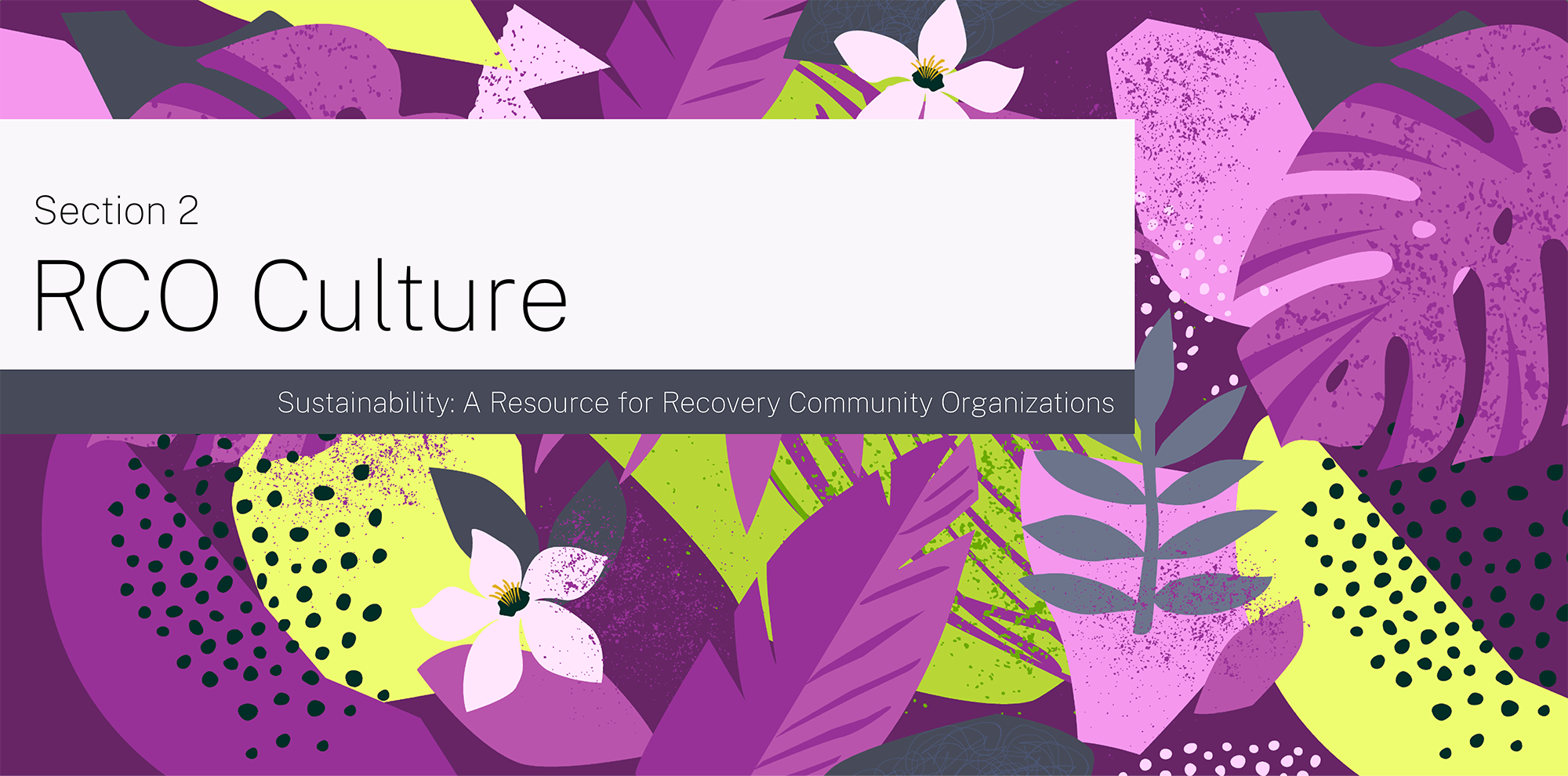
Section 2: RCO Culture
In this section, you’ll learn about revisiting your mission, vision and values, how to identify organizational stakeholders, ways to thoughtfully engage the community, and learn about what to ask before creating partnerships.
Organizational culture encompasses the rules, values, beliefs, and philosophies that guide a team’s behavior. It is often "sensed" by staff, volunteers, and community members when they interact with the organization. A strong, positive culture nurtures us. It makes us feel seen, valued, and part of something bigger. It's an environment where we're inspired to bring our best selves, to grow and contribute. It's a place that attracts and keeps talented, high-performing individuals who are engaged and driven. But what happens when our culture isn't clearly defined or communicated? Things can become ambiguous. When our shared values are unclear, we can feel lost, detached, and maybe even a bit resentful. This can lead to a workplace where people are just going through the motions.
When we actively cultivate a culture that is grounded in transparency and shared purpose, we can navigate through those ambiguous times. By clearly defining and communicating our values, we give everyone a compass to guide their actions and decisions. This clarity fuels our sense of belonging and purpose. It lights up a path where everyone feels confident about the direction we're heading in.
As an RCO leader, ask yourself these questions as you move through this Section:
- How am I intentionally or unintentionally building culture or practicing values that are in or out of alignment with my aspirations?
- Do I promote and practice transparency and thorough, timely communication with RCO staff, Board of Directors, Peer Advisory Councils, and volunteers?
- How often do I recognize staff and volunteers for a job well done?
- Do I invite feedback and take accountability for my mistakes?
- How do I demonstrate that I value creativity and innovation from my team?
- How do I provide opportunities for growth and build a sense of community within the organization?
Organizational Culture in RCOs
The foundations of a healthy RCO culture are rooted in principles such as servant leadership, open communication, shared goals, mutual respect, recognition and appreciation, and opportunities for personal and professional development. These principles provide a strong framework for promoting an environment where individuals can thrive and contribute to the success of the RCO.
However, RCOs often operate in a climate of limited resources and funding, posing challenges to their organizational culture. Insufficient financial resources often lead to understaffing, inadequate salaries, and limited professional development opportunities for staff members. Despite these challenges, RCOs can foster a healthy culture by prioritizing open communication, offering flexible work schedules, ensuring staff and volunteers feel valued and respected, and by creatively using available resources to provide professional growth opportunities.
In shaping the organizational culture of RCOs, health equity can be intentionally built by focusing on the social determinants of health. This involves recognizing the varied backgrounds and circumstances of individuals and how these factors impact access to health and recovery resources. RCOs can foster a culture of inclusivity by integrating awareness of these social determinants into their core values and operational strategies. This could include developing policies that address barriers to healthcare access, such as socioeconomic status, education, neighborhood, and physical environment, and actively working to eliminate these barriers. Training staff to be sensitive to these determinants and involving community members from diverse backgrounds in decision-making processes can ensure that the organization's culture reflects and supports health equity.
Trauma-Informed Practices in RCOs
Adopting a trauma-informed approach in RCOs involves recognizing the widespread impact of trauma and understanding potential paths for recovery. This approach sees the organization shift to practices that prioritize safety, trustworthiness, choice, collaboration, and empowerment. Training for staff on the nature and impact of trauma is crucial, equipping them to recognize signs of trauma and respond in a way that avoids re-traumatization. Programs and services should be designed considering the trauma experiences of individuals and communities served, creating an environment where individuals feel safe and supported. Collaboration with mental health professionals and incorporating peer support can be effective in promoting healing and recovery. Regular review and adaptation of practices to ensure they remain sensitive to the needs of those with trauma histories are also fundamental to a trauma-informed approach.
Cultural Agility in RCOs
Developing cultural agility in RCOs is essential for working effectively with diverse populations and cultures. This starts with fostering an organizational culture that values diversity and actively seeks to understand the varied experiences and perspectives of those they serve. Training staff in cultural competence is key, focusing not just on awareness, but also on the skills needed to interact effectively with people from different backgrounds. This includes understanding cultural norms, communication styles, and health beliefs. RCOs should also engage with the communities they serve to gain insights into their specific needs and preferences. Building a diverse team, including leadership, can provide a range of perspectives and experiences that enrich the organization’s approach. Regular reflection and evaluation of practices with a focus on cultural agility ensure continuous learning and adaptation.
Here are some simple ways for RCOs to get started with improving organizational culture:
Prioritize communication: Even with limited time and resources, open and clear communication should be a priority. Encourage regular team meetings, consistent one-to-one meetings, and create other spaces for dialogues where staff can share their thoughts, concerns, and ideas. Actively listen to each other, respecting diverse perspectives and experiences. Giving and receiving feedback is a skill that can be strengthened and supported. Introducing simple tools like this Situation-Behavior-Impact model could be a good place to start. Make time in regularly scheduled team meetings for all staff to present on the communication tools they find helpful.
Cultivate self-awareness: Encourage staff and volunteers to reflect on their personal strengths and challenges. Provide opportunities for introspection, which can help staff understand their strengths, identify growth areas, and recognize where they feel stuck. Free (and fun) online assessment tools, like the Saboteur Assessment from Positive Intelligence, may spark discussions about strengths individuals bring to the team while helping everyone to think about areas they may want to improve.
Set clear boundaries: As researcher and storyteller Brené Brown says, "Clear is kind. Unclear is unkind". Setting boundaries starts with the organization. For instance, if RCOs aim for an engaged and energized staff, leaders need to foster a culture that values rest and time to recharge. Consider how often you've sent an email to staff members after 9 p.m. or worked continuously over the weekend. Reflect on the unspoken message this sends. If RCO leaders cultivate an "always on" culture, most staff will feel the need to do the same. If the organization upholds life-work balance values, and reflects this in policies and practices, staff will feel supported and comfortable taking time off to recharge.
Provide ongoing training and resources: Offer professional development opportunities to enhance staffs' skills and knowledge. This can include training in leadership development, financial management, or fundraising and resource development. Additionally, provide resources and support networks that address the unique needs of staff and volunteers. By investing in their growth, RCOs create an environment of continuous learning and personal development.
Create a culture of recognition and appreciation: Regularly acknowledge and appreciate the contributions of individuals within the RCO. Celebrate milestones, achievements, and efforts. Implement regular recognition programs such as employee or volunteer of the month and peer recognition awards. Model showing gratitude by including “shout outs” for acts of kindness and support in staff meetings.
Resources: If you are interested in learning more about changing your RCO’s culture, check out this guide on How to Create a Company Culture Roadmap.
SAMHSA’s Practical Guide for Implementing a Trauma-Informed Approach can support organization’s in implementing trauma-informed principles and practices into an organization’s structure, service delivery, and culture.
Revisiting Mission, Vision, Values
How well do we center our mission, vision, and values in our work?
One way to evaluate and improve your RCO’s structural, ideological, strategic, and emotional dimensions is to ground your organization’s work in your mission, vision, and values.
RCOs that are officially recognized by the IRS will have a mission statement and, possibly, a vision statement in their articles of incorporation. However, while an organizational purpose is a commonly required element of incorporation, over time it may not always be at the center of an organization’s decision making or culture.
RCOs start from a wonderful, loving, and generous place, and they can easily develop into being too singularly focused on what the founder thinks and forget about asking the community. As an organization seeks to develop into a thriving RCO supporting a particular community in a particular way, keep in mind and regularly check in on these things: “How do we use our mission statement, vision statement, and our values to shape and focus the work we do, the way we make decisions, and the way we show up in and through our work?” Built into your mission, but often forgotten in the daily focus on service details, these aspects of your organization should push you to be clear, listen and respond to the community’s voices and perspectives, and drive your decisions.
Let’s talk about Founder’s Syndrome…
Becoming a 501(c)(3) nonprofit can sometimes be a bittersweet journey for founders. Many of them take this path fueled by passion and a genuine desire to make a positive impact in the lives of the most vulnerable members of their community. However, as the transition is made to a nonprofit and a board of directors is put in place, the dynamics can shift. Founders often find themselves in a different role, moving from the driving force behind the all decisions to becoming employees, while the board assumes responsibility for strategic and fiduciary decisions.
While this change can be disheartening at first, it’s essential to recognize the valuable role that the board of directors plays in shaping the future of the organization. Their expertise and oversight ensure that the RCO remains aligned with its mission, while also navigating financial sustainability and long-term planning.
Mission
Have we used our mission statement to reflect on our efforts lately? If not, can we set aside some time to check in on how well our current efforts align with our mission?
Reflecting on an existing mission statement is a valuable process that allows RCOs to assess their alignment with their current goals, values, and the needs of the recovery community they serve. This self-reflection helps RCOs ensure their mission statement remains relevant, impactful, and inclusive.
Here are some steps an existing RCO can take to reflect on their mission statement:
- Engage the recovery community: Seek input from individuals in recovery, their families, and community stakeholders. This can be done through surveys, focus groups, or town hall meetings. Actively listen to their perspectives and incorporate their voices into the reflection process. Remember, the recovery community's input is essential in shaping an impactful mission statement.
- Assess RCO values: Evaluate the core values that guide your RCO. Are they still aligned with the changing needs of the recovery community? Reflect on whether the RCO's values still reflect the principles of hope, empowerment, self-determination, and community connectedness.
- Evaluate RCO impact: Reflect on the impact your RCO has madeon the recovery community. Look at the outcomes, successes, and challenges you have experienced. Assess whether your mission statement accurately reflects your RCO's achievements and goals. Identify areas for improvement and consider how your mission statement can better showcase your RCO's dedication to supporting long-term recovery.
- Analyze external factors: Consider the external factors that influence your RCO's work, such as changes in policies, funding, or community needs. Reflecting on these factors helps you identify if there are any shifts in focus or priorities that need to be reflected in your mission statement. This analysis ensures your RCO remains adaptive and responsive to the evolving recovery landscape.
- Seek input from stakeholders: Engage with your board, staff members, volunteers, and other key stakeholders. These individuals possess valuable insights into the RCO's operations and impact. Encourage them to share their perspectives on the strengths and weaknesses of the current mission statement. Collaboratively brainstorm ideas and suggestions for refining and strengthening the mission statement.
- Craft a revised mission statement: Based on the insights gathered from the above steps, work towards refining and updating your mission statement. Ensure it clearly communicates the purpose of your organization, the values it stands for, and the impact it aims to achieve. Strive for a concise and memorable statement that resonates with the recovery community and effectively conveys your RCO's dedication to promoting long-term recovery.
Consider stating the mission statement at the start of every meeting. Making it a part of everyday discussions can be helpful in ensuring you are planning and making decisions with the mission in mind!
Examples of powerful mission statements:

American Red Cross: “To prevent and alleviate human suffering in the face of emergencies by mobilizing the power of volunteers and the generosity of donors.”

Greenpeace: “Greenpeace is an independent campaigning organization, which uses non-violent, creative confrontation to expose global environmental problems, and to force the solutions which are essential to a green and peaceful future.”

MoMA: “To collect, preserve, study, exhibit, and stimulate appreciation for and advance knowledge of works of art that collectively represent the broadest spectrum of human achievement at the highest level of quality, all in the service of the public and in accordance with the highest professional standards.”
Vision
How have I used our vision statement to help tell our story or shape new projects?
A vision statement creates just that: a vision for how the world will be different because of the RCO’s efforts. Think of your vision statement as your RCO’s “why” to the mission’s “what and how”. Revisiting your RCO’s vision statement asks you and your team to step away from the day-to-day hustle, set aside any doubts, and ask the question, “what if…?” What if the RCO accomplished all it set out to do? What would that world look like?
Remember you’re not alone in this…redoing your vision statement involves engaging the community—consider conducting interviews, surveys, and focus groups with the broad range of people who support your RCO—participants and families, individuals living in the community you serve, dedicated volunteers and donors.
Resource: Here is a tool to help your team review and revise your RCO’s Mission and Vision.
Values
Have I reflected on our values lately? If not, are the dominant cultural norms working and helping us fully support our communities?
Whether or not an RCO has a set of value statements or a list of values, how you operate and communicate will hold and reflect a particular set of values and will shape the culture of your RCO.
Culture is all around us, yet it is difficult to name or point to. Because of this, culture and “the way we do things around here” can sabotage your values or goals. Without purposeful reflection and intention, RCOs will tend towards reflecting a leader’s or society’s dominant cultural norms.
Organizational culture is developed by how we embody our mission, vision, and values, and how we work with one another. RCOs are working to create healthy communities supporting individuals wherever they are in their recovery journey. To create these types of communities, RCO’s must begin the work internally by creating and maintaining work and office cultures that reflect their aspirations.
Resource: For more information about organizational culture and how it influences staff, check out this resource by Bamboo.
Community & Stakeholder Engagement
How do we ensure the voice and ideas of the local community drive our programs and services?
If you are running an RCO, you are likely familiar with the saying “Nothing about us without us!” This isn’t just a catchy phrase - it is at the center of how RCOs do their work. RCOs intentionally include people who have or are currently living with substance use challenges, family members, and recovery allies in the design and development of the organization, its programs, mission, vision, and policies. This is often referred to as the participatory process.
Keeping the voice and vision of the community at the center of everything you do strengthens sustainability. Organizations that become disconnected from the communities they serve risk organizational decline, so it’s important to create and maintain ways to get continuous feedback from the community.
For community and stakeholder engagement strategies, RCOs should focus on inclusive participation that acknowledges and addresses the diverse needs of their community. This involves identifying and involving stakeholders who are impacted by health disparities but are often excluded from decision-making. Respectful invitations to these groups can be achieved through targeted outreach and by creating safe, accessible platforms for their involvement. To ensure effective communication and engagement, RCOs must recognize the unique barriers different groups may face, such as language barriers, literacy levels, and cultural differences. Strategies like providing multilingual resources, utilizing various communication channels, and fostering a culturally competent environment can help in reaching and engaging diverse stakeholders. Regularly evaluating stakeholder engagement and decision-making processes through a lens of equity ensures that the organization continuously adapts and responds to the needs of all community members.
Participatory Processes
Some examples of participatory process formats and activities include:

Town Halls are public meetings that allow community members to come together to discuss and address important issues that impact their community. These meetings are usually facilitated by local government or community leaders and provide an open forum for individuals to voice their concerns, ask questions, and propose solutions. Town Halls are an opportunity for community members to come together, share their experiences, and engage in constructive dialogue towards positive change and improvement in their community.

Community listening sessions are gatherings specifically designed to prioritize and amplify the voices of community members. These sessions provide a safe and inclusive space for individuals to share their thoughts, experiences, and ideas on various community-related topics. The purpose of community listening sessions is to ensure that the perspectives and needs of community members are heard and considered when making decisions, formulating policies, or implementing initiatives that directly impact them. These sessions promote inclusivity and foster a sense of empowerment and collective ownership within the community.

Focus groups are small, moderated discussions with a selected group of individuals who share common characteristics or experiences. These groups are often used to gather qualitative data, insights, and opinions on specific topics or issues. Through open-ended questions and guided discussions, participants are encouraged to express their thoughts, provide feedback, and share personal experiences related to the focus of the group. Focus groups are valuable in providing a deeper understanding of the motivations, perceptions, and needs of the participants, which can inform decision-making and the development of programs, policies, or services.

World Cafès are interactive and collaborative gatherings that promote meaningful conversations and collective knowledge sharing within a group or community. Participants engage in small group discussions around designated tables or stations, with each group exploring a particular theme or question. After a certain period of time, participants rotate to a different table, bringing their insights and ideas from previous discussions to contribute to the ongoing exchange. World Cafès provide a dynamic and inclusive environment for individuals to connect, share perspectives, and co-create solutions to complex issues. They encourage active participation and foster a sense of community by emphasizing the value of every participant's input.

Participant surveys are structured questionnaires designed to gather quantitative or qualitative data from individuals who have participated in a specific program, event, or experience. These surveys can be conducted in various formats, such as online or paper-based, and aim to collect feedback, opinions, and experiences to assess the effectiveness and impact of a particular intervention. By analyzing the responses, organizations and stakeholders can gain insights into the strengths, weaknesses, and areas of improvement for their initiatives, allowing them to make informed decisions and enhance their services based on the feedback received.

Asset mapping is a process that involves identifying and documenting the strengths, resources, and capacities within a community or organization. This method highlights the existing assets and potential opportunities available rather than focusing solely on deficits or problems. Asset mapping involves actively engaging community members, stakeholders, and relevant organizations to map out the tangible and intangible assets that contribute to the overall well-being and resilience of the community. By identifying and leveraging these assets, communities can work towards addressing challenges, fostering collaboration, and promoting sustainable development.

Peer Advisory Councils or PACs are an effective way to incorporate continuous feedback into RCO’s programs and services. PAC representatives act as advocates for the recovery community and ensure that the services provided in the RCO are accessible, effective, and aligned with the needs of the community. The PAC representatives collaborate closely with RCO staff and Board of Directors, regularly meeting with them to provide recommendations on program operations, group offerings, engagement strategies, peer-support services, and networking opportunities. It's worth noting that many PAC members are also active participants within the RCOs programs and/or leaders in their local recovery communities. Read more about Peer Advisory Councils and how to start one in Section 8, Boards.

Nominal group technique is a structured group process that facilitates collaborative decision-making and problem-solving. In this technique, participants are first asked to generate ideas or solutions individually. They then share their ideas with the group, and each idea is recorded without any evaluation or judgment. After all ideas have been shared, participants discuss and clarify each idea, and then individually vote or rank the ideas based on their perceived importance or relevance. The group then discusses the results of the voting and collectively determines the highest-ranked ideas or solutions. The nominal group technique encourages equal participation, ensures that all voices are heard, and promotes consensus-building within the group. It can be used to prioritize tasks, make decisions, or develop solutions that reflect the collective input of the participants.
While the specific form of a participatory process may vary depending on the needs and context of the RCO or community, having guiding principles in place is essential. These principles provide a framework for effective and meaningful participation, ensuring that the process is fair, inclusive, transparent, and accountable.
Some commonly recognized principles for participatory processes include:
- We acknowledge that individuals have valuable expertise in their own life experiences.
- We believe that every group member is qualified to participate based on their unique experiences.
- We recognize that the diverse backgrounds and perspectives of individuals contribute to the strength and vibrancy of the group and the process.
- We ensure that everyone is given an equal opportunity to voice their thoughts and ideas, even if there are disagreements.
- We actively encourage those who are typically unheard or marginalized to share their voices and perspectives.
- We respect the comfort levels of individuals and do not pressure anyone to participate if they do not feel comfortable.
- We take ownership of the process by sharing our analysis and expressing our thoughts and views.
- We engage in self-reflection, embrace critical thinking, and are open to continuous growth and improvement.
- We maintain high standards of rigor and ethics in our approach and methodology.
- We understand that our work must result in tangible action and be geared towards achieving meaningful outcomes.
Resource: Community Toolbox: Participatory Approaches to Planning Community Interventions
Understanding Your Stakeholders and Community
Who is in our community? Who are our stakeholders? What are they looking for from us, and are we effectively providing it?
Understanding who (does and does not) engage with your RCO is the first step towards creating impactful programs and services. In every community, there is a diversity of strengths, assets, and areas where support is needed. To effectively serve your community, it is essential to have a deep understanding of who makes up that community and what valuable assets they bring. Engaging in community listening sessions, hosting focus groups, and establishing Peer Advisory Councils are powerful tools. These initiatives empower individuals to share their voices, stories, and aspirations, creating a collaborative environment where everyone’s input is valued.
Community and stakeholder engagement in RCOs requires deliberate and inclusive outreach efforts. This can involve reaching out directly to underrecognized groups, making sure your organization's communications are accessible in different languages, and being mindful of cultural considerations. RCOs should also strive to ensure leadership and staff reflect the diversity of the community they seek to serve, as individuals are more likely to engage when they see themselves represented. In addition, offering programs and initiatives that address the specific needs and concerns of different groups can also encourage wider participation.
Involving Underrepresented Stakeholders in Decision-Making
Health equity in RCOs necessitates the active involvement of stakeholders often marginalized in decision-making processes. This requires identifying groups impacted by health disparities but not typically represented, such as minorities, those with limited economic resources, or individuals from various cultural backgrounds. To invite them respectfully into the RCO, strategies like reaching out through community networks, hosting open forums, and offering support for participation (like transportation or childcare) can be effective. Additionally, ensuring that meeting times and locations are accessible and considering virtual participation options can make a significant difference. It's essential to approach this with sensitivity and a genuine willingness to listen and integrate their perspectives into the organization's policies and practices.
Recognizing and engaging with stakeholders in a consistent and meaningful way is a fundamental pillar on which RCOs are built. This ongoing engagement builds trust, strengthens relationships, and fosters a sense of community ownership in the RCO’s initiatives.
*Note on what we mean by the term Stakeholders in this guide:
A stakeholder, in the context of RCOs, refers to individuals, groups, or organizations that have an interest or investment in the success and impact of the RCO. They actively contribute to, are affected by, or have the potential to influence the organization's activities, goals, and outcomes. Stakeholders can play various roles in supporting an RCO's mission and promoting a recovery-oriented community.
- Individuals in recovery: People who have or are experiencing substance use challenges. They are directly impacted by the services and support provided by the RCO.
- Family members and friends: Loved ones of individuals experiencing substance use challenges or are in recovery often play a crucial role in supporting and advocating for their family member's recovery journey.
- Recovery-focused addiction and recovery professionals: Professionals such as counselors, therapists, and peer support specialists who work in the field of addiction and recovery.
- Non-profit agencies and emerging community organizations: Other non-profit organizations and community groups that share similar goals or missions with RCOs. They may collaborate and partner with RCOs to amplify their impact and expand their reach.
- Peer Certification Boards: These boards are responsible for certifying and credentialing peer support workers who provide services within the recovery community.
- Government agencies: Local, state, and federal government entities that play a role in the policies, funding, and regulation of recovery-related services. They are important stakeholders in shaping the operating environment for RCOs.
- Donors and funders: Individuals, foundations, and organizations that provide financial support to RCOs. They have a vested interest in the RCO's ability to effectively utilize their funds and achieve positive outcomes.
Take time to consider the questions below for recognizing different stakeholder groups.
- Who are the stakeholders that are notably impacted by this decision but are not involved in the decision-making process? How can we respectfully invite them into our RCO?
- How can we effectively communicate and engage with different stakeholder groups? What are ways we unintentionally leave some groups out?
- Are there any stakeholder groups that are being underserved or overlooked? If so, how can we address this?
- How can we ensure that the voices and perspectives of all stakeholder groups are considered and valued?
- What mechanisms can we put in place to ensure ongoing evaluation of stakeholder engagement and equitable decision-making?
Partnerships and Collaborations
How do we fit within the network of nonprofits seeking to support our community? What is our unique niche or role
How could partnerships, coalitions, or collaborations help us maximize our resources, our reach, and our impact?
What are the other sectors, systems, and organizations that we should be working with in order to support the whole person/family/community?
Organizational sustainability depends on how well you work with others. The most successful RCOs know when and how to partner with other organizations or stakeholders and when to tackle something on their own. Understanding your organization’s niche, role, capacity, and objectives, and those of your broader network, can help you identify opportunities for working with others. RCOs can maximize their efforts and protect their limited resources through community partnerships, collaborations, or coalitions. Supporting the work of other nonprofits by showing up to their events, engaging with them on social media, making introductions, or providing testimonials (without demanding a certain level of visibility in return) helps lay the groundwork for partnering in the future.
Addressing Underserved or Overlooked Stakeholder Groups
Identifying and addressing underserved or overlooked groups within the community is crucial for health equity. This can be achieved by conducting community assessments to understand the specific needs and barriers different groups face. Partnerships with other community organizations can also provide insights into populations the RCO might not be reaching effectively. Once identified, targeted initiatives and programs designed to meet their specific needs can be developed. For instance, if a particular group is facing barriers due to language, providing resources in their language, or having interpreters available can make a significant difference.
Resource: Effective Community Collaboration
Think as broadly and creatively as possible as you answer the questions posed above. Think beyond the typical partnerships RCOs find with treatment centers, hospitals, housing programs, or the department of justice to include schools, barbershops, grocery stores, libraries, gyms, or other entities that support the whole person.
For example, barbershops and hair salons have long served as hubs for community engagement and conversation. They are places where people gather, share stories, and seek support. By partnering with a barbershop, an RCO can tap into this preexisting sense of community, meeting individuals in an environment that is familiar, comfortable, and accepting. This collaboration provides a unique opportunity to engage individuals who may not otherwise seek out traditional recovery resources.
To initiate this collaboration, an RCO could work closely with barbershop owners and staff to provide education and training on topics such as substance use, recovery, and the importance of a supportive community. This knowledge empowers barbers to not only become allies in the recovery process but also to identify warning signs of problematic substance use and provide appropriate guidance or referrals.
An RCO could also establish a presence within the barbershop itself, either by setting up a designated area or holding regular meetings or support groups. By physically situating recovery resources within the barbershop, individuals in need can access information, connect with others who understand their struggles, and receive guidance in a comfortable, nonjudgmental environment.
Additionally, organizing educational events or workshops at the barbershop can help raise awareness about recovery and dismantle stigma surrounding substance use challenges. By opening up dialogue and promoting understanding, an RCO could foster a sense of empathy and compassion within the wider community, creating an environment that supports and encourages honest dialogue on a difficult topic.
One aspect that sets RCOs apart from traditional treatment centers is their emphasis on advocacy and policy change. an RCO working with a barbershop could collaborate on local or regional advocacy efforts to address issues such as access to treatment, employment discrimination, or affordable housing for individuals in recovery. Through their partnership, they could help shape public policy that supports recovery and reduces barriers to healing.
Resource: Check out this resource from the Native Governance Center, Partnering with Native Nations in a Good Way Guide.
Intentionality in Partnerships
Who are we partnering with? Why?
Who are we NOT partnering with? Why not?
Avoid the trap of creating partnerships just for the sake of having a memorandum of understanding (MOU) with a given organization. Building partnerships should align with your RCO’s mission and values. It’s also important that your partners truly understand what your RCO has to offer, and that both organizations have a clear understanding of what is expected of the relationship. For example, if reciprocal referrals are a part of the relationship, then it should be clearly stated in the MOU document. Many different types of grants, state grants in particular, require a certain set of MOUs. It is important to do the work of getting to know the organizations that you are building partnerships with and how both entities can best serve the needs of your target populations.
Here is a link to a Memorandum of Understanding Template you can use to edit and use with your RCO.
Below is a list of questions to ask when considering whether or not to enter into a potential partnership:
- What is the mission and vision of the potential partner organization?
- How does this potential partnership align with our RCO's goals and objectives?
- What resources can this organization bring to our partnership?
- What are the potential risks and challenges of entering into this partnership?
- How will responsibilities and decision-making be shared in the partnership?
- What is the process for resolving conflicts within the partnership?
- What is the potential impact of this partnership on our RCO's reputation and relationships with other stakeholders?
- How will the success of the partnership be measured and evaluated?
- Are there any legal or regulatory implications of this partnership?
- What are the financial aspects of this partnership and how will they be managed?
- What is the duration of this partnership and what are the terms for renewal?
- How will communication between the two organizations be facilitated?
- What are the expectations for each organization in this partnership?
- How will this partnership affect our current programs and services?
- How will the partnership be terminated if it does not meet our expectations or objectives?

Section 2: Pause & Reflect
At the end of each section, take time to reflect on what was presented, consider how it applies to your unique situations, structures, and goals of your RCO, and identify possible next steps.
At the end of each Section, take time to reflect on what was presented, consider how it applies to your unique situations, structures, and goals of your RCO, and identify possible next steps.
- What information or ideas were new, interesting, helpful, or hopeful in this section?
- How does this section guide your organization in adapting, improving, or building upon the RCO Guiding Principles and Practices listed below? For each point, consider "What is going well?" and "What could be better?"
- Led and governed by members of the recovery community
- Grassroots, local, community-based decision-making
- Participatory practices are emphasized, promoting community involvement and collaboration.
- All pathways and recovery journeys are honored and celebrated
- Diverse, equitable, and inclusive policies, practices, and services
- Recovery oriented language that is strengths-based and person-centered
- What areas of your organization do you think might need some work or review?
- What is one small step you can take in the next 2–3 weeks to begin doing that work or review? (This could be emailing someone to schedule a meeting, finding and printing the most up to date draft of something, or asking someone to review draft language.)

CAPRSS Considerations
At the end of some sections in this guide, you will find a segment titled “CAPRSS Considerations”. These segments highlight particular aspects of Council on Accreditation of Peer Recovery Support Services (CAPRSS) standards that relate to the section topic. See the paragraph below for more information on pursuing CAPRSS accreditation.
Partnership, collaboration, and cooperation are principles that align with CAPRSS's commitment to a participatory approach to programmatic decision-making. This emphasizes the importance of involvement with the recovery community, peer leaders, key stakeholders and collaborating partners.
The synergy between an organization’s goals, vision, and values and CAPRSS's dedication to being firmly rooted in the values of the recovery community is fundamental. The establishment of an environment that embodies diversity and inclusiveness is critical for creating a welcoming workplace that promotes both recovery and wellness.
These are reflected in CAPRSS’ domain of Recovery Principles, Culture and Climate and its principle-related standards of Core Recovery Principles, Core Recovery Culture and Values, and Recovery Climate/Environment. As well as the performance-related standards for Determining Community Strengths and Needs, Planning and Evaluating the Supports/Services found in the CAPRSS domain of Peer Support: Core Competencies.


